

Tulip Tank Top. At first bud a tulip’s elongated petals are packed tightly, protectively hugging its center, but it doesn’t take long for the stance of the petals to soften.

Those lovely ovals separate slightly and open finally, giving a glimpse of what’s inside. Even as the petals flounce, they remain in an embrace, now catching the sunlight, as well as the attention of admirers. Wanting to experience the beauty and femininity of a tulip’s structure, I designed this Tulip Tank Top to wrap and overlap, to gently hug my center… maybe even to attract some admirers! I took advantage of the beauty and drape of Louet’s 100% linen Euroflax, knowing it would fall gracefully and catch the light with movement.
I knit this piece primarily in stockinette stitch for a smooth finish and a pretty, little curl along the short-row-shaped edges. Frankie Morello Poncho Multicolore - Paleari. A knit and crochet community. What is the best way to get started?
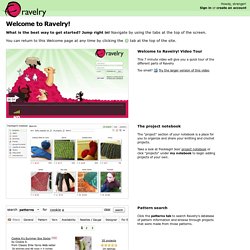
Jump right in! Navigate by using the tabs at the top of the screen. You can return to this Welcome page at any time by clicking the tab at the top of the site. Wolltwister und weiteres Strickmaschinenzubehör von Strick-Allerlei-Voigt.de. Free Lace Shawls Knitting Pattern Link Directory. Increasing Your Options. By Sandi Rosner It is entirely possible to make a sweater without ever increasing or decreasing the number of stitches.
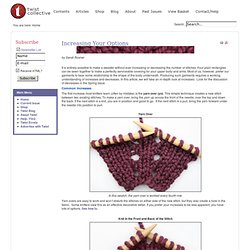
Four plain rectangles can be sewn together to make a perfectly serviceable covering for your upper body and arms. Decoding Decreases. By Sandi Rosner For a sweater to take shape in a form other than your basic rectangle, you’ll need to add and/or subtract some stitches along the way.
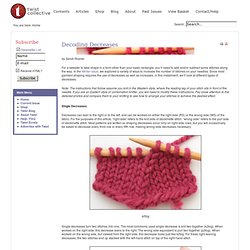
In the Winter issue, we explored a variety of ways to increase the number of stitches on your needles. Since most garment shaping requires the use of decreases as well as increases, in this installment, we’ll look at different types of decreases. Note: The instructions that follow assume you knit in the Western style, where the leading leg of your stitch sits in front of the needle. If you are an Eastern style or combination knitter, you will need to modify these instructions. Single Decreases. How to knit a lifted increase. The Invisible Ribbed Bind Off For 1x1 Rib.
I’m almost done putting my toe-up socks video e-book together, and I wanted to give you a sneak peek of my favorite technique: The stretchy, hemmed-edge invisible ribbed bind-off.

Summer 2006. Okay, so you've put hours and hours (and hours) into knitting and you've finished.

Now to bind off. (Some people call it casting off because there's a lovely symmetry to "casting on, casting off", isn't there?) But which bind off? Do you usually bind off too tightly? I know I do. Vogue Knitting. Knitting Increases. An increase is simply adding a stitch to the knitting.
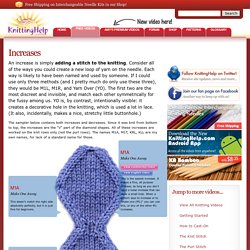
Consider all of the ways you could create a new loop of yarn on the needle. Each way is likely to have been named and used by someone. If I could use only three methods (and I pretty much do only use these three), they would be M1L, M1R, and Yarn Over (YO). The first two are the most discreet and invisible, and match each other symmetrically for the fussy among us. YO is, by contrast, intentionally visible: it creates a decorative hole in the knitting, which is used a lot in lace. The sampler below contains both increases and decreases. Make One Away This doesn't match the right side absolutely perfectly, but it is just fine for beginners. view continental videoview english video This is the easiest increase. Make One Left view continental videoview english video This creates the exact same stitch as Make One Away, it just does it tighter and more invisibly.
Knit Right Loop. Emily Ocker’s cast-on – for flat circular knitting. Learn to Knit - How to Knit - Knitting Instructions. All the instruction, tips and advice you need to learn how to knit.

From casting on, knitting, purl and binding off to the basic tools and patterns for your first project, here's all the information new knitters need to be a success. Casting On There are many different methods of getting stitches on the needles, and every knitter seems to have her or his favorite. If you've never knit before, this is where you need to start. Knitters with more experience will find information on a variety of cast on methods. Basic Knitting Stitches and Styles There are two basic stitches involved in knitting: the knit stitch and the purl stitch. Casting On Stitches. Also known as Double Cast-On or Continental Cast-On view video This is my favorite cast on method, I use it almost exclusively.
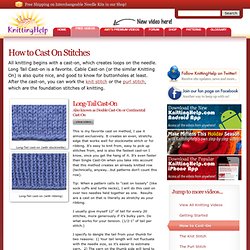
It creates an even, stretchy edge that works well for stockinette stitch or for ribbing. Standards and Guidelines for Crochet and Knitting. The publishers, fiber, needle and hook manufacturers and yarn members of the Craft Yarn Council have worked together to set up a series of guidelines and symbols to bring uniformity to yarn, needle and hook labeling and to patterns, whether they appear in books, magazines, leaflets or on yarn labels.

Our goal is to make it easier for industry manufacturers, publishers and designers to prepare consumer-friendly products and for consumers to select the right materials for a project and complete it successfully. Included are: We urge manufacturers, publishers and designers, to adopt these guidelines. Downloads of the graphic symbols are available at this web site at no charge.
Machine. TKGA. Crochet. Vidéos.